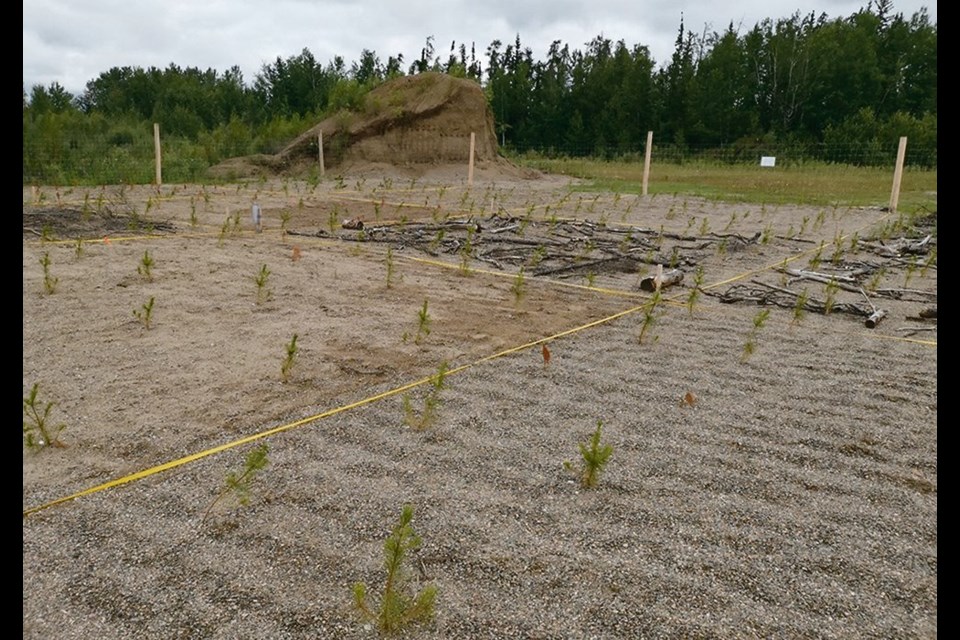CANDLE LAKE — A study done by Saskatchewan Polytech on soil reclamation involving biochar could change the face of soil in Canada.
Andrew Carpenter of Reclaimit, an organization that specializes in forest reclamation, carried out a commercial reclamation project in the northern oil sand region of Saskatchewan. It didn’t produce the desired results, so he approached Sask Polytech.
Originally intended to cover one growing season in 2019, the study was expanded to three years and took place near Candle Lake, Sask.
The study was done on a gravel pit site that mimicked sandy soils of the northern oilsands region. In all, 600 pine seedlings were arranged in blocks with a variety of different soil amendments, but it was biochar that showed the most promise. That prompted the researchers to expand the study to look specifically at biochar.
David Halstead, a biologist from Sask Polytech, said the biochar was first treated with vermicompost or worm castings as a form of inoculant.
“We inoculated (the biochar) and basically charged it with nutrients,” Halstead said. “So, then we put the biochar into the sand and it basically did the job of a fertilizer.”
Carpenter knew what biochar was and the role it could play in soil health. Haiti, one of the most deforested countries in the world, has lost most of its good soil. Carpenter watched biochar in action in the country, and saw biochar turn land into soil that could produce food.
“I saw biochar in action and it blew me away,” Carpenter said. “When you see white beach sand that is now capable of producing food because it’s a functioning soil, it doesn’t take long to be convinced.”
Rob Lavoie, president and chief executive officer of Airterra, the company that provided the biochar for the research, said biochar is pure carbon. It can be made out of virtually any type of waste where all of the lighter gases are distilled from the biomass.
But for the biochar that helps with soil reclamation, it needs to be a bit more specific.
“Anything to do with soils, what you want is a material that has a high porosity and a high surface area and has some integrity,” Lavoie explained. “So as such, the high-quality biochar is usually made from woody materials.”
Lavoie said the porosity of woody biochar pulls in and holds moisture. With a larger surface area, the biochar absorbs more nutrients, and prevents those nutrients from leaching away in the rain. Biochar also attracts microbes.
Lavoie said the best current use for biochar on farms is for animal bedding.
“If you have char in the bedding, the char will absorb those volatilized gases to a great degree,” Lavoie said. “So, you actually start capturing nutrients even before the bedding goes up to be composted.”
“Co-composted char with residual agricultural organics has a higher value than just simply blending pristine biochar into finished compost. Because what happens during the co-composting process is that each particle of biochar becomes coated with really high plant available nutrients.”
Once the bedding is composted, Lavoie said it can be broadcasted onto the field like a fertilizer. He said it can also be made into pellets.
Halstead said the research done at Sask Polytech could have a big impact on the environment.
“We’re using compost to inoculate the biochar, so we’re reducing landfill volumes while converting biochar into fertilizer.”
“And since we’re putting biochar into the soil, we’re sequestering carbon long term. And because the plants themselves are supercharged by compost-inoculated biochar, they’re enhanced growth captures carbon at an increased rate from the atmosphere... so it’s win, win, win.”
Carpenter said he hopes more work can be done regarding biochar.
“It needs to be further tested here in Canada, and to be consistently applied.”
Halstead said the data from the third year of the federally funded study (NSERC, NRC) is still being compiled.




